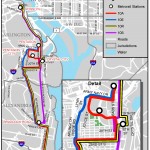
Last fall we let you know about changes we proposed on the bus routes serving Hunting Point and the Mount Vernon Avenue/Jefferson Davis Highway corridor. We developed the original proposal based on recommendations that emerged from a comprehensive study conducted on Routes 10A, 10B, and 10E in 2013. In the weeks leading up to our September public hearings as well as in oral and written testimony given at those hearings we received numerous comments and opinions on the options we presented. We incorporated that feedback into an adjusted proposal and presented it to Metro’s Board of Directors for approval.
On Sunday, March 30, 2014, Metro will implement these changes that will impact Metrobus routes 9E, 10A, and 10E. We believe riders will benefit from faster travel times and improved connections between Alexandria, Crystal City and Rosslyn.
What these changes mean for you:
Route 10A riders:
During the a.m. peak period northbound (from Hunting Point) and the p.m. peak period southbound (to Hunting Point), Route 10R will replace 10A service. Route 10R will provide a direct connection between Crystal City and Rosslyn bypassing the Pentagon. Existing 10A passengers traveling to the Pentagon may take a Route 10E bus or transfer to Metrorail at Braddock Road Station. These changes do not impact off-peak, weekend, a.m. peak period southbound (from the Pentagon) or p.m. peak period northbound (to the Pentagon) 10A service. Read more…
Categories: Service Changes Tags: 10A, 10E, 10R, 10S, Braddock Road, ccpy, Crystal City, Metrobus, Pentagon, Pentagon City, Rosslyn, service
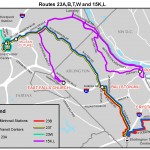
On Sunday, March 30, 2014, Metro will improve bus service in the Tysons-McLean-Crystal City corridor. The changes, which will affect Metrobus routes 23A and 23C, were part of a series of improvements presented at our public hearings in the fall of 2013 and will provide significantly improved bus service for the majority of riders on these routes. This restructuring will also allow better coordination between Metrobus, Metrorail and Fairfax Connector bus service once Silver Line service begins.
What these changes mean for you:
Route 23A riders:
Route 23A will operate between Crystal City and Tysons Corner Center weekdays during non-peak periods and at all times on weekends. During weekday peak periods, new routes 23B and 23T will replace Route 23A service. New Route 23W will replace all service between Tysons Corner Center and Tysons-Westpark Transit Station.
Route 23C riders:
Routes 23B and 23T will replace all 23C service between the intersection of Old Dominion Drive and Chain Bridge Road in McLean and Crystal City. Route 23C service will be discontinued. Alternate service in the McLean and Langley areas is provided by Metrobus Routes 15K and 15L on Chain Bridge Road and Dolley Madison Boulevard. Read more…
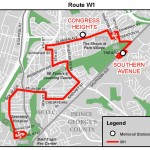
Last fall, Metro presented numerous proposed bus service changes at our public hearings. Many of these proposals impacted bus routes in Southeast DC and we received significant feedback from riders and other concerned citizens. We heard you, we listened, and we updated or discarded our proposals based on your feedback. Our original set of proposals included changes to:
What is happening now?
On Sunday, March 30, 2014, Metro will implement major changes on several Metrobus routes in Southeast DC, including the M2, M8, M9, V7, V9, and W4. These changes will improve neighborhood circulation and provide the direct connections to shopping and community services that residents have requested. These changes will also allow Metro to improve service on local high ridership routes. Here is what these changes mean for you: Read more…
Categories: Service Changes Tags: 30s Line, 31, 32, 34, 36, 74, Congress Heights, Fairfax Village, M2, M8, M9, Naylor Road, Potomac Avenue, Southern Avenue, U2, V7, V9, W1, W4

Effective with Metro’s March 30, 2014 service changes, Metrobus will implement major changes to bus service in Laurel on routes 87, 88, 89 and 89M. During a comprehensive study of the Laurel bus routes, riders expressed a desire for more reliable service that operates later into the evening. These changes will begin to address those issues.
What these changes mean for you:
Route 87 riders:
During weekday morning peak periods, trips leaving Laurel at 5:48, 6:25 and 7:11 a.m. will continue from Greenbelt Station to New Carrollton Station. During weekday afternoon peak periods, three trips to Laurel will begin service at New Carrollton Station and will serve Greenbelt before continuing to Laurel. These three trips are scheduled to depart New Carrollton at 4:05, 4:55 and 6:20. Read more…
The Transportation Planning Board (TPB) estimates that without funding commitments from Congress, the District of Columbia, Maryland, and Virginia for Metro’s ongoing maintenance and core capacity improvements, as many as 32,000 future daily transit riders would be pushed onto the roadways instead.
In a recent report, the TPB cites that under the current funding trajectory, Metrorail riders will face significant crowding and experience less service reliability in the future. Critics often cite low forecasts of future Metrorail ridership from the TPB as a reason to avoid committing robust levels of funding for transit. What they don’t tell you is that the ridership numbers emerging from the travel demand model are manually “capped” so that there is no ridership growth beyond 2020 – the year beyond which current levels of maintenance funding levels expires. In other words, because regional leaders have not committed to funding transit, those that forecast travel demand have decided to stop forecasting increases in transit usage. Were it not for this artificial “cap”, travel demand forecasts would show much higher numbers of future transit use. We all know that such a “cap” ignores the last 10-15 years of increasing transit usage region-wide (performance analysis of the CLRP  )
)
Metro’s strategic plan, known as Momentum, proposes a number of core capacity improvements to handle more riders, and offers a plan of initiatives necessary to remove the so-called “transit constraint” placed on the system in 2000. Metro 2025, one of the main components of Momentum, includes:
Read more…
The Los Angeles area is aggressively leveraging billions in local tax dollars to transform the region into a more vibrant place with a variety of transportation options.

Measure R Spending Breakdown
The conventional wisdom today is that the days of big expensive transportation investments are over. Los Angeles apparently didn’t get the memo. The main transportation planning and development agency in the LA area, the Los Angeles County Metropolitan Transportation Authority (LA Metro), is currently leading the development of the nation’s largest regional transportation expansion program. The program of projects, Measure R, was overwhelmingly approved by more than two-thirds of LA county voters in 2008, and raised the local sales tax one-half cent. The half-cent sales tax is expected to raise $40 billion over 30 years (including an estimated $590 million in 2012) to provide the lion’s share of funding for Measure R transportation projects around the region, helping Angelenos avoid some of the area’s legendary traffic congestion. Not satisfied with the already impressive pace of expansion, LA Metro’s Board of Directors is now exploring a second ballot measure that could come as early as 2016.
Measure R includes an impressive array of transit projects, including the Orange Line Bus Rapid Transit extension, Expo and Regional Connector light rail lines, and the Westside Subway, among others. Below is a map of the transit projects fully or partially funded by Measure R (click on the map below for the interactive version):
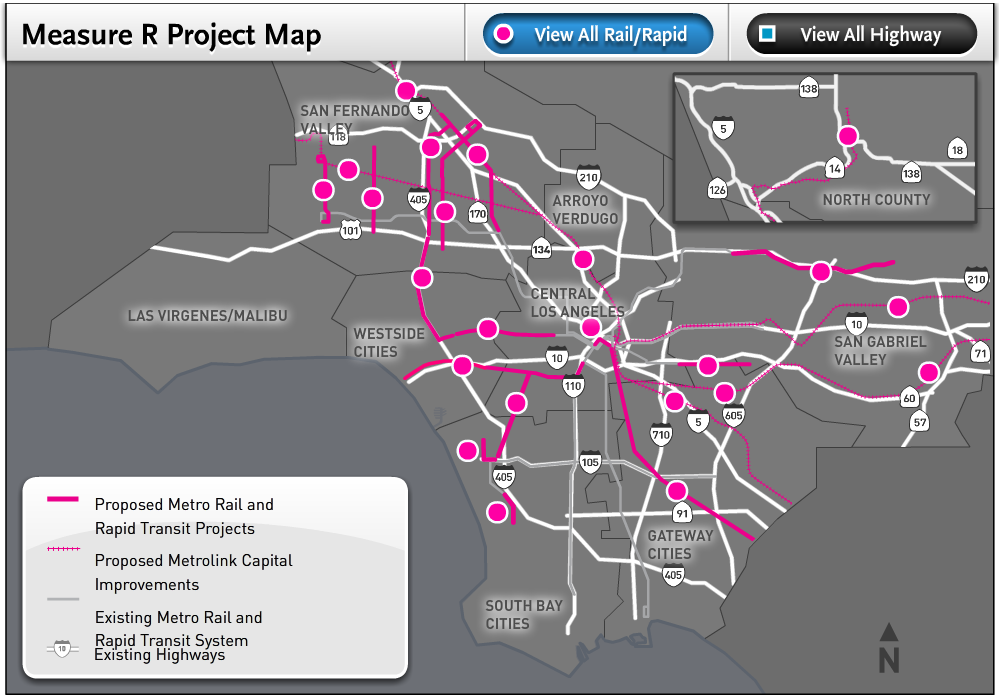
Measure R Transit Map (source: LA Metro)
Read more…
In anticipation of the Silver Line, nearly twenty development projects, with an estimated value of more than $18 billion, are underway near the Metrorail stations, helping attract riders and generating valuable benefits for Fairfax County.
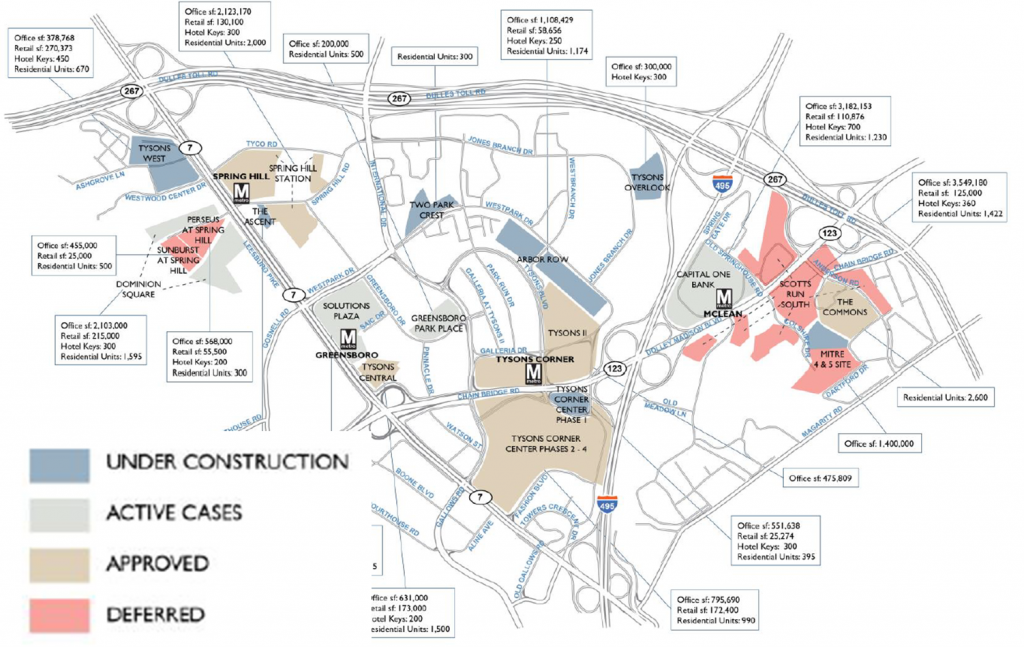
Ahead of the Silver Line, many development projects are underway around the new stations. Image from Cushman and Wakefield, click link at left for full report.
In a new report, the real estate firm Cushman & Wakefield documented twenty real estate development projects “in the pipeline” near the five new Silver Line stations. Some are under construction now, others are in the approvals process, and a few are on hold, but together they total:
- Over 20 million sq. ft. of new office space, which would increase the total office space in the Tysons area by 40%.
- Over 2 million sq. ft. of new retail space. That’s more than twice the size of the Tysons Galleria mall.
- 17,800 new residential units, or more than double the current population of the Tysons area.
- 9,300 hotel rooms
Metro estimates that these projects are valued at more than $18 billion, and will generate millions per year in tax revenue for Fairfax County (estimated using industry-standard construction costs). Some of this tax revenue will be captured by special tax districts in the Tysons and Silver Line areas. In 2011, we estimated that Fairfax County received around $30 million in tax revenues from properties within a half-mile of its five existing non-Silver stations.
The development brings great benefits to Fairfax County and will encourage riders to use the Silver Line, but there remains a strong need to improve the walking and biking environment near the new stations. Pedestrian and bicycle access will be key to meeting our ridership goals for the new Metrorail line, but walking and bicycling conditions remain challenging in the area.
Metro is investing in a series of bus stop improvements across the region that will improve the rider experience and fully comply with the Americans with Disabilities Act (ADA).
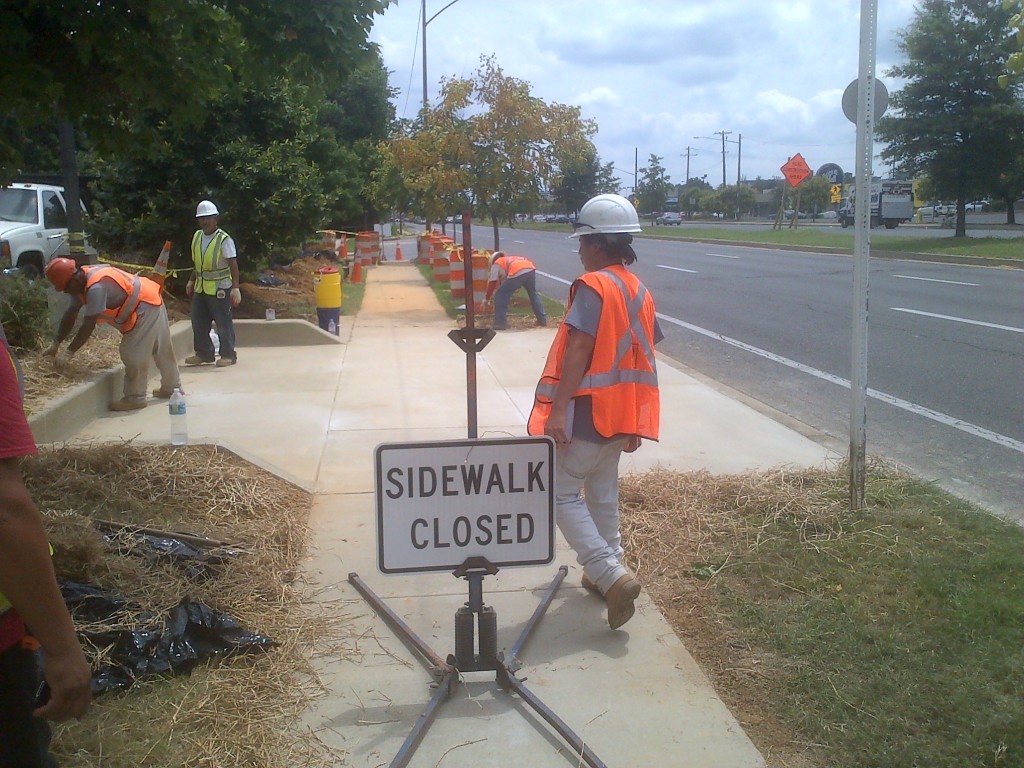
Construction of the improvements for the stop on Branch Avenue and Silver Hill Road
Metro is investing in bus stop improvements to make bus riding easier for everyone, but especially for persons with disabilities. Improvements have been completed along two routes; the J4 route (College Park- Bethesda MetroExtra) and the P12 (Eastover-Addison Road Station). Addtional work was also done in the City of Greenbelt. These stops were selected as a part of the regional TIGER grant bus priority initiative designed to improve bus speeds and customer facilities along high demand corridors throughout the region.
To meet ADA requirements, bus stops must have four attributes:
• The pedestrian (landing) pad must have a firm, stable surface that is at least 5’ by 8’ (located at front door stopping location).
• The pedestrian pad must connect to the curb.
• The sidewalk must connect to the pad.
• The sidewalk must have a pair of curb ramps (leading to the bus stop).
At some locations, Metro was able to provide additional improvements, such as shelters, and in-street concrete pads, which are better able to withstand the heat and weight of a bus than regular asphalt. The specific improvements are described
Read more…
We want to hear from you! Interested 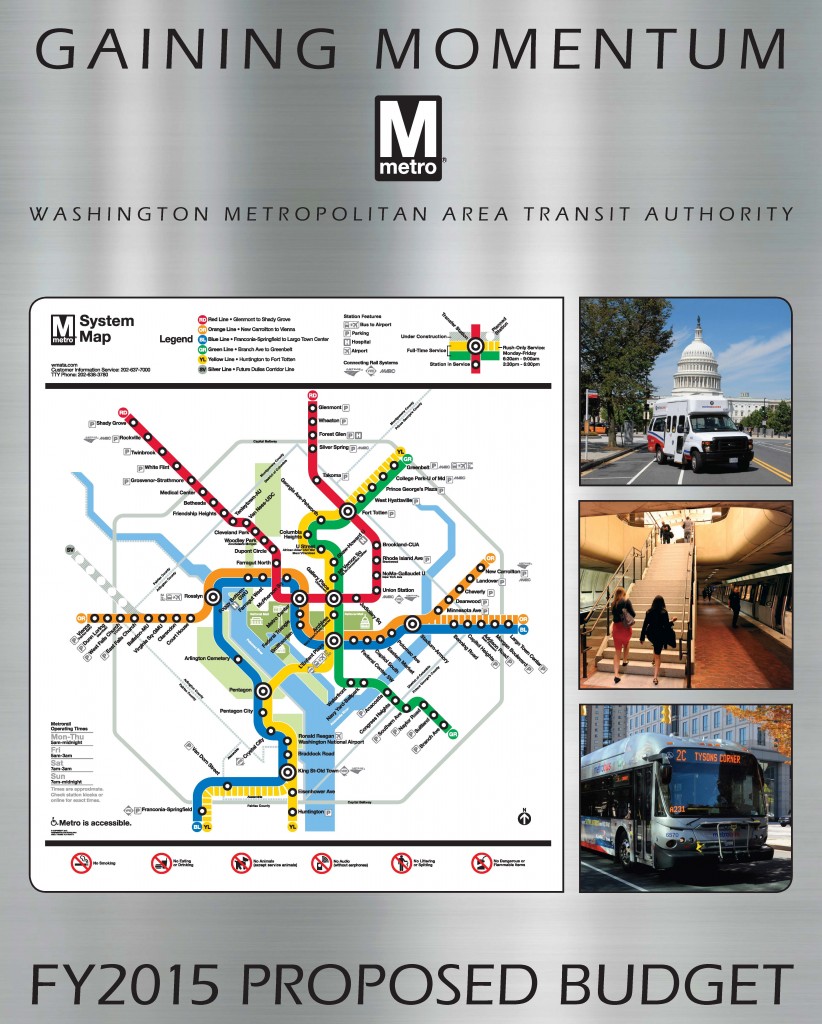 in the FY2015 budget? Answer our survey or participate in an upcoming public meeting. Want to talk more long-term strategy? Connect on MindMixer.
in the FY2015 budget? Answer our survey or participate in an upcoming public meeting. Want to talk more long-term strategy? Connect on MindMixer.
We are seeking feedback from riders and offering multiple ways to comment on the proposed FY2015 budget and fare changes, as well as Metro’s Capital Improvement Program. You can participate in any or all of the following:
- Survey: The survey includes questions about the fare changes, costs, and the benefits you will see going forward. The survey is open until 5 p.m. on February 11, 2014.
- Public Hearings: The six public hearings will provide an opportunity for riders to give formal testimony on the docket of proposed budget actions.
Looking to get into the weeds and talk about some long(er)-term opportunities? We have started a new discussion on MindMixer to gather your ideas and thoughts about priorities and potential future changes to the balance of funding between riders and local government, continuing to allow fares to be paid in cash on Metrobus, parking, new fare options, and priorities for a down payment on Metro2025 initiatives.
Read more…
New buildings right near Metrorail stations are 23-30% more valuable than buildings farther away, showing that our funding partners can generate significant property tax revenues from Metro.
A recent study shows that Metrorail stations in Arlington’s Rosslyn-Ballston corridor are powerful anchors for economic development and value. The report, by the real estate firm Cushman & Wakefield, showcases the substantial value the region can realize with good transit-oriented development policies near stations. Among the report’s findings:

Offices in the Rosslyn-Ballston corridor right near Metro command higher rents. Source: Cushman & Wakefield via washingtonpost.com. Click for original context.
- Being able to walk to Metro is worth a lot. New office buildings within 500 feet of a station in Arlington’s Rosslyn-Ballston corridor are earning a 30% premium over buildings under construction just a quarter-mile away. For apartment buildings, the premium is 23%. No wonder walk access to Metrorail is on the rise, especially from those close by the station!
- 92% of over 20 million square feet of office space under construction in the Rosslyn-Ballston corridor is within a quarter mile of a Metrorail station.
- Conversely, new office buildings built farther than a quarter-mile from Metro are worth 18% less in rent.
These “rail premiums” of 23-30% are significantly higher than the 7-9% we found in our “Business Case for Transit” study, because of several significant differences in methodology. We looked at the assessed value, not the market/rental rate of property. Also, we looked at all properties in the region, rather than just those under construction in one corridor.
Although the presence of Metrorail creates this value premium near stations, Metro does not receive any of these revenues directly, even though continued rebuilding and improvements are needed to address state of good repair and relieve capacity issues in the corridor.
Nevertheless, this report certainly confirms that Metrorail increases property tax revenues, and shows just how big that value can be in certain markets.





 )
)





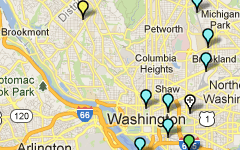
Recent Comments